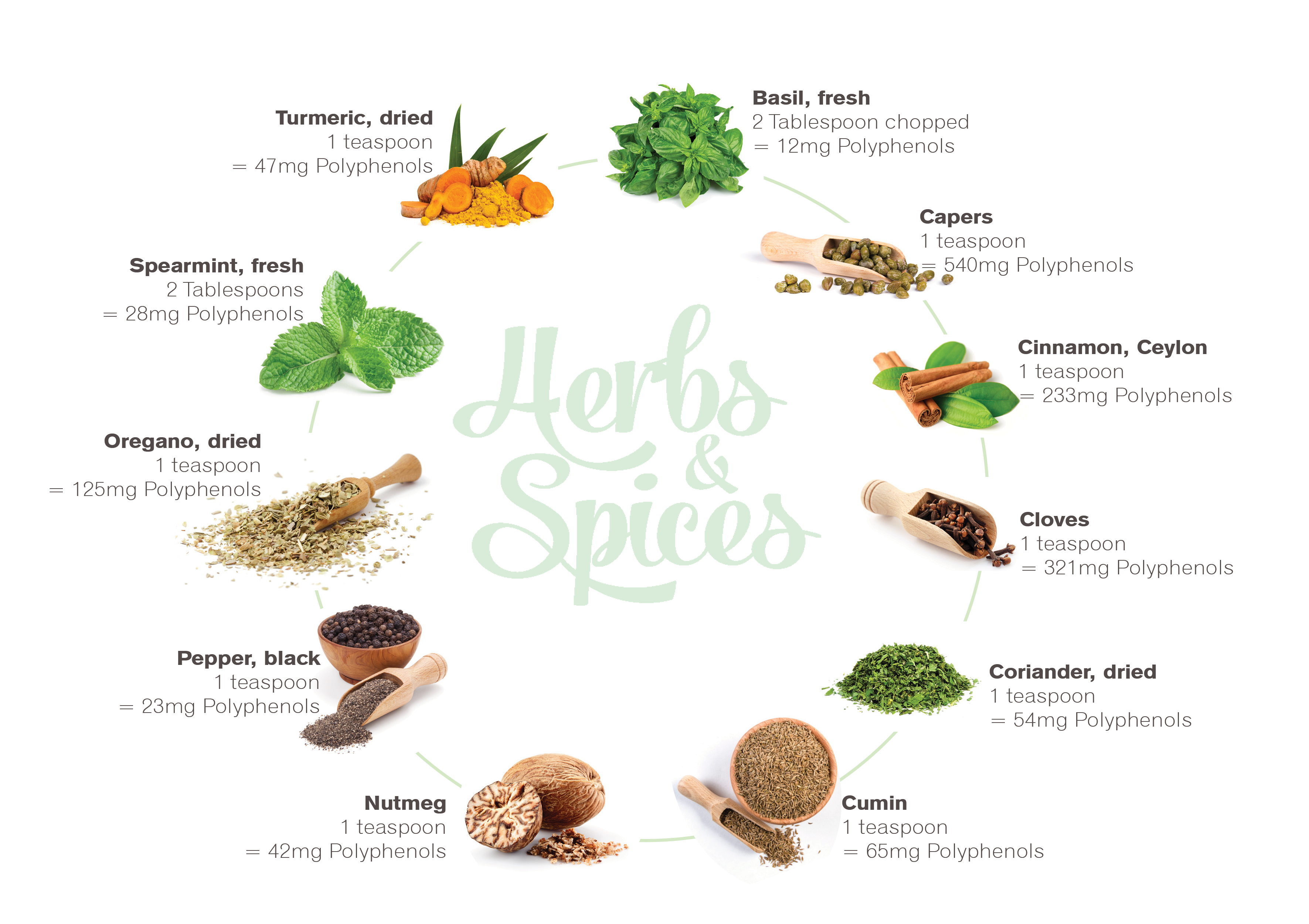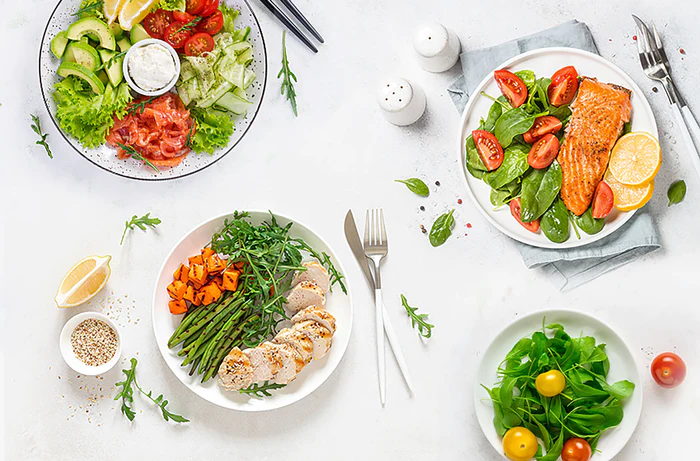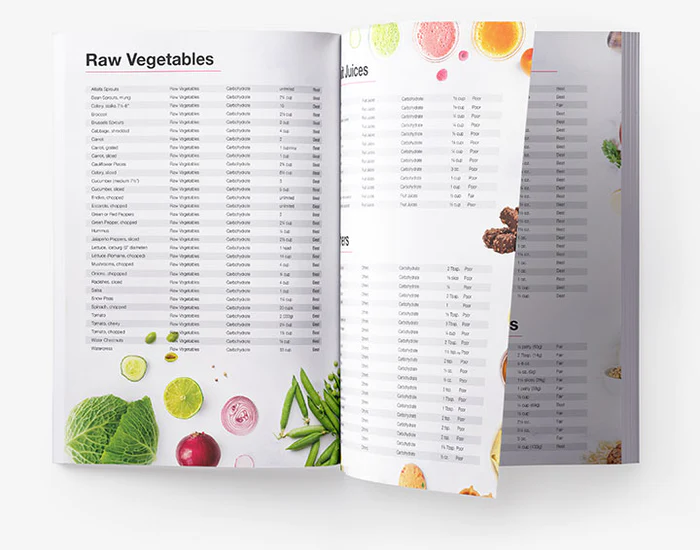Most of us don't think to incorporate herbs and spices into all of our meals, but it's a way to gain the greatest health benefits out of the foods we eat. Have you ever thought of adding cinnamon or turmeric to your yogurt or throwing herbs and spices into your lunch salads or homemade dressings? Not only do herbs and spices add flavor and color to your meals, but they’re full of antioxidants. Herbs and spices have been used for centuries for their medicinal purposes and as a preservative to extend the shelf-life of foods in addition to their culinary contributions of taste, flavor and aroma 1. Here we’ll explain how they differ, why they are beneficial for your health and some helpful tips for buying, storing and using them.
The Difference Between Herbs and Spices
When it comes to terminology herbs and spices are often used interchangeably, but they do differ with regards to which part of the plant they come from. Simply put, herbs are the leaves of plants and spices are everything else such as the fruit, seeds, and roots. Both can be used fresh or dried, but typically spices are dried 1. Fun fact…plants can be both an herb and a spice like dill and coriander. In the U.S. the leaves and stems of the coriander plant are the herbs we know as cilantro or Chinese parsley and the seeds are the spice coriander 2.
What are the Health Benefits of Herbs and Spices?
Every day we are exposed to stresses in both our internal and external environment that can impact the health of our body. This can include UV exposure, radiation, chronic or low-grade inflammation, smoking or exposure to microorganisms. Exposure to these stresses can produce what are called free radicals in our cells and tissues. High levels of free radicals, also known as oxidative stress, play a key role in the onset of diseases such as cardiovascular disease, diabetes, cancer and Alzheimer’s. This is where the intake of polyphenols and antioxidants becomes critical for our overall health. Polyphenols help to scavenge and neutralize free radicals and restore balance to our cells. Since herbs and spices are rich sources of polyphenols they can help minimize this damage.
Polyphenol Content of Herbs and Spices

The info graphic above highlights some commonly used herbs and spices and the amount of polyphenols they contain 3. View the full list here. The goal of this isn’t to make anyone start taking out their calculator while preparing meals, but to highlight that anywhere you can incorporate herbs and spices into your daily intake it only enhances the health benefits you gain.
Even when used in small amounts some herbs and spices are incredibly rich in polyphenols. For example, 1 tsp of capers supplies 540 mg of polyphenols. To reach this same level you would have to consume about 1 2/3 cups of blueberries or 3 cups of raw broccoli. The benefit of using herbs and spices is they can fill in the gaps when your intake of other polyphenol rich foods falls short. Plus they have no sugar and little to no calories.
How Many Polyphenols Should We Consume Each Day?
Dr. Sears recommends aiming for a minimum of 1,000mg of polyphenols per day for general wellness. This can come from a combination of foods such as herbs, spices, fruits, vegetables, cocoa, and plant-derived beverages such as coffee and tea.
Tips When Using Herbs and Spices
Buying: Look for herbs that are fragrant and look fresh. Avoid ones with brown spots or tiny holes from insects. Try and buy only what you need to avoid waste. When it comes to spices if you buy them whole and grind when you need them (a cheap coffee grinder does the trick) they can maintain their freshness longer.
Storing: Keep in a cool place away from light and moisture. Try to avoid storing in the cabinet above or to the side of your oven where the heat can deteriorate them quicker. Keep tightly covered and replace after 1 to 3 years. Spices that are part of the red pepper family such as chili powder and paprika stay fresher longer and retain their color better if stored in the refrigerator 4.
Planting: For herbs you use regularly consider planting in pots outside or in small containers you can keep on your windowsill over the winter months. This way you can take what you need when you need it.
Recipe Considerations: If your recipe calls for fresh herbs but you only have dried, 1 teaspoon of dried herbs equals the amount in one tablespoon fresh 4. To get the most flavor when using dried herbs and spices crush them using the back of a spoon prior to including in a recipe to release some of their aromatic flavor or rub between your hands (clean of course!) and then add to your recipe.
Nutritional Considerations: Typically exposing foods to heat can destroy the polyphenol content of them. In a study by Chohan and colleagues microwaving, simmering and stewing may actually increase the antioxidant levels of herbs and spices (e.g. cinnamon, sage, rosemary, ginger) whereas dry heat, grilling, or frying that result in foods to brown may decrease the polyphenol or antioxidant levels.
References
- Yashin A, Yashin Y, Xia X, Nemzer B. Antioxidant Activity of Spices and Their Impact on Human Health: A Review. Antioxidants (Basel). 2017 Sep 15;6(3).
- Cilantro vs Coriander: What's the Difference? Available at: https://www.healthline.com/nutrition/cilantro-vs-coriander. Accessed: October 13, 2020.
- Polyphenol Content of Herbs and Spices. Phenol Explorer Database. Available at: http://phenol-explorer.eu/reports/44. Accessed: October 13, 2020.
- 10 Easy Tips to Keep Herbs and Spices Fresh and Flavorful. Available at: http://dish.allrecipes.com/10-herb-and-spice-storage-tips/







Let Us Know What You Thought about this Post.
Put your Comment Below.